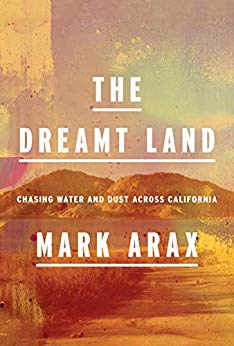This came across my radar when I was perusing the local League of Women Voters schedule. I missed the author’s. talk to them, but certainly picked up on the book and put it on my wish list.
This is literary non-fiction concerning the area in which I live, the San Joaquin Valley in California. which has had water problems since Europeans and Americans started messing with it – or maybe before. What with gold and wheat and cotton and cattle and fruit and people and now nuts, everything needs water. But like all resources, water is limited and due to the human condition, greed is not.

*******
The Dreamt Land: Chasing Water and Dust Across California
by Mark Arax
2019 / 523 pages
read by Mark Arax – / 25h 32m
rating: 9.5 – history
*******
The book was highly informative and great fun to read because, having lived in this area for more than 50 years, I know almost all the places mentioned although not the individual people or really local history. I’m certainly familiar with big agriculture and water wars and most of the commodities and their struggle with the open land, a lot of which is vanishing. (I live in the Southeast part of the Valley, the Porterville, Exeter, Terra Bella part, up against the Sierra Nevada, where our naval oranges have been grown on mostly smaller farms for decades and made millionaires of the farmers around Exeter.) When you grow almonds on the desert it takes more water than is normally available so water is “mined” (yes) and shipped in and traded and used up – legally or not. And big money plays a big part in where it goes – that along with archaic and ambiguous water laws. .
Arax starts with the natives in their pre-colonial environments and moves along, not quite chronologically, through the final days of the last great drought which lasted from 2011 tot 2018. (The book was published in 2019 but there is an epilogue). There is so much covered – from the Natives and the early growers to the water-thirsty almonds and pomegranates of the recent years and from the floods to the droughts with all the legal and illegal shenanigans to gain water to accom-modate the growth of the Southland. Bits of memoir are included as Arax is from a family of Armenian immigrants in Fresno, the heart of the Valley, and has spent decades writing about the area and its issues for years in the LA Times.
The social mix and that problem is also addressed. Mexican labor, documented and undocumented, helps makes this area of the country rich as much as water and agriculture. Without the labor theses poor workers provide we have nothing. Many of the players in this history are immigrants from somewhere, Armenia, Germany, Sweden and other places. Arax is good.
I enjoyed reading this so much I postponed the new Alexander McCall Smith book until I’d finished. And I see there’s a new John Grisham book out now, too.
If you’re from the Central Valley this is a must read just to know how we got to this point – (its burning north hand south at the moment). If you’re from California at all it’s fascinating. If you’re from the US and interested it’s well worth it. Fwiw, this book will be in my list of top nonfiction books read all year and I’ve read some good ones. 🙂 Happy reading!

We are having similar water wars in our part of the world: farmers in drought demanding a bigger share of the available water, while the rivers dry up causing irreparable damage…
LikeLiked by 1 person
I took a better look at the fields yesterday as I drove to an out of town doctor’s appointment. I really appreciated what I saw, even the few cotton fields which are coming back as a result of the drought (low water needs). It’s hard to believe this area was a huge Indian wetlands and marsh before the Americans and Europeans came.
I’ll bet a lot more areas are going to be having water problems of one kind or another as global warming continues . 😦
LikeLike
Yes, with consequences for whether the world’s population can be fed. Already in Australia there are movements towards more sustainable eating but it’s going to take a lot more than just reducing the amount of red meat that’s consumed.
LikeLike
More sustainable eating does NOT include munching on pomegranates and almonds from the desert.. That’s how we use up our water for “upscale” eating. (The workers can’t drink their own water.) Our aquifers have diminished and the earth has actually sunk in a lot of places. The wells ran dry many times and the farmers just did their dirty deeds and dug deeper and deeper. That’s what happens! (Aaaaaarrrrgggghhh!!!). Farmers should live on the land they work, too.
LikeLike